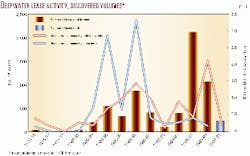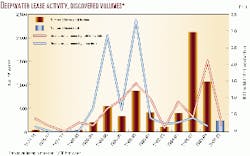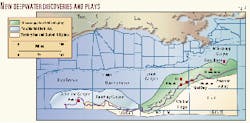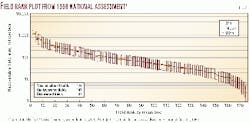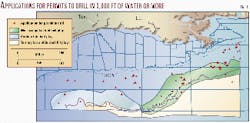Deepwater wells, those in greater than 1,000 ft of water, are now producing more than 700,000 bo/d on the U.S. Gulf of Mexico (GOM) Outer Continental Shelf (OCS).
For the first time deepwater oil production exceeds that of GOM shelf and slope wells. This milestone represents the emergence of a bright future for the deepwater GOM.
This production increase and anticipated future increases are coming from hydrocarbon trends and plays that were conceived, leased, and drilled from the mid-1980s through the late-1990s. These plays are far from mature, and analysis of field-size distribution data shows that many additional field discoveries are expected in these plays.
Looking to future potential GOM hydrocarbon reserve additions, the US Minerals Management Service (MMS) is encouraged by the leasing, drilling, and recent discoveries in several new hydrocarbon trends and plays. Chris Oynes, regional director of the Gulf of Mexico OCS Region, recently stated when referring to the deepwater GOM, "Its future looks bright, as many new geologic trends are only now seeing the first exploratory drilling."1
Deepwater explosion
Several positive factors, i.e., the Deepwater Royalty Relief Act, improving oil prices, and several key deepwater discoveries, combined to stimulate leasing and exploration.
The bars in Fig. 1 illustrate the number of leases receiving bids in the deepwater GOM from 1974 to 2000 in 2-year periods. The solid red curve is the volume of hydrocarbons discovered in each of these periods. These volumes include MMS reserve and resource estimates as well as those announced in company press releases and other public sources.
This curve shows an increase in discovered volumes in the late 1980s and a second, larger increase in the late 1990s. The dashed green line relates the discovered hydrocarbon volumes to the date the lease was acquired rather than the year of discovery.
This line shows that many of the large discoveries in the late 1990s are on leases acquired in the mid and late 1980s. Consequently, we have yet to see the impact of successful exploratory drilling on the large number of leases awarded during 1996-99.
Nascent plays
Many of these post-1995 leases are in untested or very sparsely tested plays.
a href="javascript:OpenLargeWindow(265014,650,666,'IS');">The outlines of four significant new plays and trends, as well as the proposed Sale 181 Eastern GOM sale area, are also shown.
Obviously, it is difficult to predict with a high degree of certainty the exploration targets a company has in mind when bidding on a lease. Additionally, a lease may have potential targets in more than one hydrocarbon play. Fig. 2 shows the high number of leases in the new play and trend areas. It is important to note that three of these plays and trends extend into the Sale 181 area.
Four plays or trends have received the most interest because of recent but limited drilling and/or active leasing. Fig. 3 outlines these new trends and plays in the Western and Central GOM. These include the following:
1. The Mississippi Fan Fold Belt Play (MFFB) that now has five announced discoveries in predominantly Miocene reservoirs. This play may be divided into two regions:
- Compressional folds partially or wholly in front of the Sigsbee escarpment. Discoveries announced in this region include Atlantis (Green Canyon 699), Neptune (Atwater Valley 575), and Mad Dog (Green Canyon 826).
Significant hydrocarbon volumes have been encountered on these large structures. For example, although appraisal drilling is in the early stages, Spirit Energy believes the Mad Dog discovery has ". . . gross resource potential within the drilling unit to be in excess of 400 MMboe and as much as 800 MMboe."2
Another example is from BHP's press release: "The Broken Hill Proprietary Co. Ltd. (BHP) today announced further results from the Atlantis 2 appraisal well confirming a major oil accumulation with a multi-hundred million barrel resource potential. . . ."3
- Compressional folds that occur beneath the Sigsbee Salt Canopy (SSC). Correctly imaging these subsalt structures is a major challenge requiring the industry to develop and use a number of pre-stack, depth-migrated seismic techniques. Announced discoveries at K2 (Green Canyon 562) and Champlain (Atwater Valley 63) show that successful exploration of the fold belt structures beneath the SSC is possible. These discoveries open a very large area north of the Sigsbee Escarpment to future exploration.
2. Another play with virtually no exploration drilling is the Perdido Fold Belt Play. The play is similar to the MFFB Play in that it consists of very large compressional fold belt structures. However, the plays differ in age of the structures and targeted reservoirs. One discovery, BAHA (Alaminos Canyon 600), has been drilled, but the well failed to reach its primary Mesozoic objectives.
A second exploration well is being drilled at Alaminos Canyon 557. The results of this well may have a significant impact on future exploration activity in this play. Like the MFFB Play, the compressional folds extend a considerable distance landward beneath the SSC. The play is less heavily leased than the MFFB because of greater water depths over much of its extent.
3. Tertiary Fan and "Buried Hill" plays are located seaward of both the Sigsbee Escarpment and fold belt plays. These plays are undrilled but have undergone recent leasing.
Geophysical mapping shows a number of possible exploration targets. These include large abyssal fans, structural drape closures over buried hills, the buried hills themselves, local sedimentary buildups (reefs?), and detrital deposits related to the buried hills. These targets are conceptual and await future drilling.
4. The most talked about recent discovery in the deepwater GOM is in the middle of a well-leased area, the Crazy Horse (Mississippi Canyon 778) discovery.
"With estimated recoverable oil of at least 1 billion barrels of oil equivalent (boe), it is the biggest discovery ever in the Gulf deepwater."4
Crazy Horse is one of three discoveries on "turtle structures." "Pluto" (aka BS&T) (Mississippi Canyon 718) and "Mensa" (Mississippi Canyon 731) are the other two.
The Crazy Horse and Pluto discoveries are partially covered by shallow salt canopies. Recent leasing and high bid amounts suggest that industry recognizes additional targets on similar turtle structures.
Sale 181 is an undrilled deepwater area in the Eastern Planning area.
Recent seismic interpretation shows that trap types in this region are analogous to those found in the west-adjacent Central GOM area. Consequently, the sale area's hydrocarbon potential is considered to be very similar to that area.
Future reserves
Recent discoveries in lightly drilled plays will add significant hydrocarbon volumes to GOM hydrocarbon reserves.
How significant might these discovery volumes be? One responsibility of MMS is to provide an estimate of future hydrocarbon reserves expected to be discovered in the GOM.
To support this estimate, MMS has completed a detailed analysis on all productive hydrocarbon plays in the GOM. A "play" is a group of genetically related reservoirs defined on the basis of depositional style, age, and structural or trap style. A single field may produce from more than one play.
This analysis of producing plays has been published in the two-volume "Atlas of Northern Gulf of Mexico Gas and Oil Reservoirs, 1997" (Atlas).5 6 An updated version of the atlas with production data to Jan. 1, 1999, is to be published on CD-ROM early in 2001. The atlas provides an important knowledge base of existing productive hydrocarbon plays (65 plays producing in 984 fields).
These data are then incorporated into the MMS's "Assessment of Conventionally Recoverable Hydrocarbon Resources of the Gulf of Mexico and Atlantic Outer Continental Shelf,"7 also known as the National Assessment (NA). The atlas documents existing production and reserves in the GOM; the NA estimates future hydrocarbon discovery volumes from established, frontier, and conceptual plays.
The NA is based on the productive hydrocarbon plays documented in the atlas. Boundaries for each play are first established by using reserve and production information from the atlas. Then, data from unsuccessful wells and the most recent exploratory wells are incorporated.
The result is a map of the geologic limits of the play, and an estimate of the number and size of future discoveries in the play. Therefore, the NA provides an estimate of hydrocarbon volumes yet to be discovered in existing productive plays. The NA also uses analog plays from the atlas and other data sources to provide realistic models for important parameters used in estimating hydrocarbon volumes for plays with no production or limited production history.
Analysis of play and field data strongly suggests a lognormal distribution of discovery sizes. This assumption is the basis for the MMS projections of field sizes. The MMS's latest NA will be published on CD-ROM in early 2001.
Positive outlook
Fig. 4 is a semi-log plot of the expected distribution of all fields, both discovered and predicted to be discovered, in this water depth range. Known fields are shown by a square. The mean size of predicted future discoveries is shown by a horizontal bar, with the 5th and 95th percentile expectation shown by a vertical bar.
This example shows that 127 new field discoveries with expected reserves (mean estimate) totaling more than 20 billion BOE occur in this water depth range.
Most of these discoveries are anticipated to occur in several relatively new plays where a limited number of wells have already resulted in potentially large discoveries that have significant positive impact on the estimated reserve volumes. The geologic limits of these potential play areas are very extensive, and a large undrilled lease inventory provides the opportunity to achieve the projected results.
Industry's first response to these new discoveries has been increased leasing through these plays, followed by exploratory drilling. Fig. 5 shows the locations of applications for a permit to drill filed from 1999 through August 2000 for exploratory wells in greater than 3,000 ft of water.
As appraisal wells increase the reserves of known discoveries, and as drilling results in new discoveries, this reserve projection moves from forecast to reality. The future of the deepwater GOM may be very bright indeed. F
References
- Baud, R.D., Peterson, R.H., Doyle, C., and Richardson, G.E., "Deepwater Gulf of Mexico: America's emerging frontier," Minerals Management Service, Gulf of Mexico OCS Region, New Orleans, OCS Report MMS 2000-006, 2000, 89 p.
- Unocal, press release, "Unocal announces second significant deepwater Gulf of Mexico discovery," Apr. 12, 1999.
- Broken Hill Proprietary Co. Ltd. (BHP), press release, "Atlantis drilling results confirm major Gulf of Mexico oil discovery," Aug. 28, 2000.
- BP Amoco press release, "BP Amoco announces four major deepwater finds in Gulf of Mexico," July 15, 1999.
- Seni, S.J., Hentz, T.F., Kaiser, W.R., and Wermund, E.G. Jr., "Atlas of northern Gulf of Mexico gas and oil reservoirs, Vol. 1: Miocene and older reservoirs,"University of Texas Bureau of Economic Geology, Austin, 1997.
- Hentz T.F., Seni, S.J., and Wermund, E.G. Jr, "Atlas of northern Gulf of Mexico gas and oil reservoirs, Vol. 2: Pliocene and Pleistocene reservoirs,"Bureau of Economic Geology, Austin, 1997.
- Lore, G.L., Ross, K.M., Bascle, B.J., Nixon, L.D., and Klazynski, R.J., "Assessment of conventionally recoverable hydrocarbon resources of the Gulf of Mexico and Atlantic Outer Continental Shelf as of Jan. 1, 1995," Minerals Management Service, Gulf of Mexico OCS Region, New Orleans, OCS Report MMS 99-0034, 1999.
